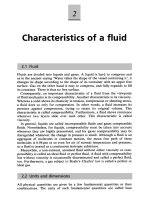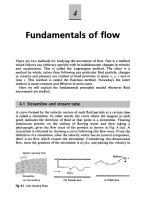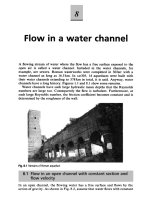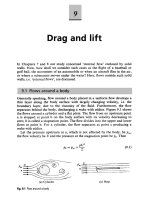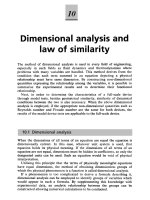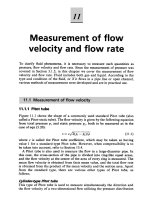Mchardy supercritical fluid cleaning
Bạn đang xem bản rút gọn của tài liệu. Xem và tải ngay bản đầy đủ của tài liệu tại đây (18.71 MB, 304 trang )
SUPERCRITICAL FLUID
CLEANING
Fundamentals, Technology and
Applications
Edited by
John McHardy
Hughes Aircraft Company
El Segundo, California
and
Samuel P. Sawan
University of Massachusetts Lowell
Lowell, Massachusetts
NOYES PUBLICATIONS
Westwood, New Jersey, U S A .
Copyright 0 1998 by Noyes Publications
No part of this book may be reproduced or utilized
in any form or by any means, electronic or
mechanical, including photocopying, recording or
by any information storage and retrieval system,
without permission in writing from the Publisher.
Library of Congress Catalog Card Number: 97-44663
ISBN: 0-8 155- 14 16-6
Printed in the United States
Published in the United States of America by
Noyes Publications
369 Fairview Avenue, Westwood, New Jersey 07675
10 9 8 7 6 5 4 3 2 1
Library of Congress Cataloging-in-Publication Data
Supercritical fluid cleaning : fundamentals, technology, and applications /
edited by John McHardy and Samuel P. Sawan.
p.
cm.
Includes bibliographical references and index.
ISBN 0-8155-1416-6
1. Supercritical fluids. 2. Cleaning. 1. McHardy, John.
11. Sawan, Samuel P.
TP156.E8S82 1998
667-dc21
97-44663
CIP
MATERIALS SCIENCE AND PROCESS TECHNOLOGY SERIES
Series Editors
Rointan F. Bunshah, University of California, Los Angeles
Gary E. McGuire, Microelectronics Center of North Carolina
Stephen M. Rossnagel, IBM Thomas J. Watson Research Center
Electronic Materials and Process Technology
CHARACTERIZATIONOF SEMICONDUCTOR MATERIALS, Volume 1: edited by Gary E.
McGuire
CHEMICAL VAPOR DEPOSITION FOR MICROELECTRONICS: by Arthur Sherman
CHEMICAL VAPOR DEPOSITION OF TUNGSTEN AND TUNGSTEN SILICIDES: by
John E. J. Schrnitz
CHEMISTRY OF SUPERCONDUCTOR MATERIALS: edited by Terrell A. Vanderah
CONTACTS TO SEMICONDUCTORS: edited by Leonard J. Brillson
DIAMOND CHEMICAL VAPOR DEPOSITION: by Huimin Liu and David S. Dandy
DIAMOND FILMS AND COATINGS: edited by Robert F. Davis
DIFFUSION PHENOMENA IN THIN FILMS AND MICROELECTRONIC MATERIALS:
edited by Devendra Gupta and Paul S. Ho
ELECTROCHEMISTRY OF SEMICONDUCTORS AND ELECTRONICS: edited by John
McHardy and Frank Ludwig
ELECTRODEPOSITION: by Jack W. Dini
HANDBOOK OF CARBON, GRAPHITE, DIAMONDS AND FULLERENES: by Hugh 0.
Pierson
HANDBOOK OF CHEMICAL VAPOR DEPOSITION: by Hugh 0. Pierson
HANDBOOKOF COMPOUND SEMICONDUCTORS: edited by Paul H. Holloway and Gary
E. McGuire
HANDBOOK OF CONTAMINATION CONTROL IN MICROELECTRONICS: edited by
Donald L. Tolliver
HANDBOOK OF DEPOSITION TECHNOLOGIES FOR FILMS AND COATINGS, Second
Edition: edited by Rointan F. Bunshah
HANDBOOK OF ION BEAM PROCESSING TECHNOLOGY: edited by Jerome J. Cuorno,
Stephen M. Rossnagel, and Harold R. Kaufman
HANDBOOK OF MAGNETO-OPTICAL DATA RECORDING: edited by Terry McDaniel
and Randall H. Victora
HANDBOOK OF MULTILEVEL METALLIZATION FOR INTEGRATED CIRCUITS: edited
by Syd R. Wilson, Clarence J. Tracy, and John L. Freeman, Jr.
HANDBOOKOFPLASMA PROCESSINGTECHNOLOGY: edited by StephenM. Rossnagel,
Jerome J. Cuomo. and William D. Westwood
HANDBOOK OF POLYMER COATINGS FOR ELECTRONICS, 2nd Edition: by James
Licari and Laura A. Hughes
V
vi
Series
HANDBOOK OF REFRACTORY CARBIDES AND NITRIDES: by Hugh 0. Pierson
HANDBOOK OF SEMICONDUCTOR SILICON TECHNOLOGY: edited by William C.
O'Mara, Robert 8. Herring, and Lee P. Hunt
HANDBOOK OF SEMICONDUCTOR WAFER CLEANING TECHNOLOGY: edited by
Werner Kern
HANDBOOKOF SPUTTER DEPOSITIONTECHNOLOGY: by KiyotakaWasa and Shigeru
Hayakawa
HANDBOOK OF THIN FILM DEPOSITION PROCESSES AND TECHNIQUES: edited by
Klaus K. Schuegraf
HANDBOOK OF VACUUM ARC SCIENCE AND TECHNOLOGY: edited by Raymond L.
Boxman, Philip J. Martin, and David M. Sanders
HANDBOOK OF VLSl MICROLITHOGRAPHY: edited by William B. Glendinning and John
N. Helbert
HIGH DENSITY PLASMA SOURCES: edited by Oleg A. Popov
HYBRID MICROCIRCUIT TECHNOLOGY HANDBOOK, Second Edition: by James J.
Licari and Leonard R. Enlow
IONIZED-CLUSTER BEAM DEPOSITION AND EPITAXY: by Toshinori Takagi
MOLECULAR BEAM EPITAXY: edited by Robin F. C. Farrow
SEMICONDUCTOR MATERIALS AND PROCESS TECHNOLOGY HANDBOOK: edited
by Gary E. McGuire
ULTRA-FINE PARTICLES: edited by Chikara Hayashi, R. Ueda and A. Tasaki
Ceramic and Other Materials-Processing and Technology
ADVANCED CERAMIC PROCESSING AND TECHNOLOGY, Volume 1: edited by Jon G.
P. Binner
CEMENTED TUNGSTEN CARBIDES: by Gopal S. Upadhyaya
CERAMIC CUTTING TOOLS: edited by E. Dow Whitney
CERAMIC FILMS AND COATINGS: edited by John 6. Wachtman and Richard A. Haber
CORROSION OF GLASS, CERAMICS AND CERAMIC SUPERCONDUCTORS: edited by
David E. Clark and Bruce K. Zoitos
FIBER REINFORCED CERAMIC COMPOSITES: edited by K. S. Mazdiyasni
FRICTION AND WEAR TRANSITIONS OF MATERIALS: by Peter J. Blau
HANDBOOKOF INDUSTRIAL REFRACTORIES TECHNOLOGY: by Stephen C. Carniglia
and Gordon L. Barna
SHOCK WAVES FOR INDUSTRIAL APPLICATIONS: edited by Lawrence E. Murr
SOL-GEL TECHNOLOGY FOR THIN FILMS, FIBERS, PREFORMS, ELECTRONICS
AND SPECIALTY SHAPES: edited by Lisa C. Klein
SPECIAL MELTING AND PROCESSING TECHNOLOGIES: edited by G. K. Bhat
Contributors
Shirish M. Chitanvis
Los Alamos National Laboratory
LQSAlamos,NM
John L. Fulton
Battelle
Pacific Northwest Laboratories
Richland, WA
John E. Giles, Jr.
Honeywell
Space and Strategic Avionics Div.
Clearwater, FL
Michael 0.Hogan
Battelle
Pacific Northwest Laboratories
Richland, WA
Glen Huse
Green Oaks, IL
Kevin Jackson
Battelle
Pacific Northwest Laboratories
Richland, WA
Kenneth E. Laintz
Isotag L.L.C.
Isotag Research
Los Alamos, NM
Gurusamy Manivannan
BioPolymerix
Tyngsboro, MA
John McHardy
Hughes Aircrafi Company
El Segundo, CA
Ramamurthy Nagarajan
IBM
San Jose, CA
x
Contributors
Chris W. Patterson
Los Alamos National Laboratory
Los Alamos, NM
Max R. Phelps
Battelle
Pacific Northwest Laboratories
Richland, WA
Laura J. Silva
Battelle
Pacific Northwest Laboratories
Richland, WA
L. Dale Sivils
Los Alamos National Laboratory
Los Alamos, NM
Robert J. Purtell
IBM
Thomas J. Watson Research Center
Yorktown Heights, NY
Samuel P. Sawan
Polymer Science/plasticsEngineering
program
University of Massachusetts, Lowell
Lowell, MA
Yeong-Tarng Shieh
Polymer Science/PlasticsEngineering
Program
University of Massachusetts, Lowell
Lowell, MA
Charles W. Smith
Fairview, PA
W. Dale Spall
Isotag L.L.C.
Isotag Research
Los Alamos, NM
Jan-Hon Su
Polymer SciencdPlasticsEngineering
Program
University of Massachusetts, Lowell
Lowell, MA
Robert G. Honeywell, Jr.
Honeywell Inc.
Glendale, AZ
NOTICE
To the best of our knowledge the information in this publication is
accurate; however the Publisher does not assume any responsibility or liability for the accuracy or completeness of, or consequences
arisingfrom, suchinformation. Thisbookisintended for informational
purposes only. Mention of trade names or commercial products does
not constitute endorsementor recommendation for use by the Publisher. Final determination of the suitability of any information or
product for use contemplated by any user, and the manner of that
use, is the sole responsibility of the user. We recommend that
anyone intending to rely on any recommendation of materials or
procedures mentioned in this publication should satisfy himself as
to such suitability, and that he can meet all applicable safety and
health standards.
Preface
Although supercritical fluid (SCF)technology is now widely used in
extraction and purification processes (in the petrochemical, food and pharmaceuticals industries), this book is the first to address the new application
of cleaning. Our objective was to provide a roadmap for readers who want
to know whether SCF technologycan meet their own processing and cleaning
needs. It should be particularly helpfbl to those striving to balance the
requirements for a clean product and a clean environment. The interdisciplinary subject matter will appeal to scientists and engineers in all specialties
ranging from materials and polymer sciences to chemistry and physics. It
should also be useful to those developing new processes for other applications, and referencesgiven at the end ofeach chapter provide links to the wider
body of SCF literature.
The book is organized with topics progressing from the fundamental
nature of the supercritical state, through process conditions and materials
interactions, to economic considerations. Practical examples are included to
show how the technology has been successhlly applied. The first four
chapters consider principles governing SCF processing, detailing issues such
as solubility, design for cleanability, and the dynamics of particle removal.
The next three chapters discuss surfactants and microemulsions, SCF
interaction with polymers, and the use of supercritical carbon dioxide (CO,)
as cleaning solvent. The closing chapters focus on more practical considerations such as scaleup, equipment costs, and financial analysis.
Many contributors to this book belong to the “Joint Association for
the Advancement of SCF Technology” (JUST), a consortium established
vii
viii Preface
to fosterthe developmentand application of SCFs. Members of J U S T meet
several times each year to compare results and exchange information on their
research and development activities. A primary motivation for the formation
of J U S T was the growing worldwide need to replace ozonedepleting
compounds (ODCs) and smog-forming volatile organic compounds (VOCs)
in manufacturing processes. Although aqueous cleaning has been adopted
successfully for many applications, water is not a panacea and SCF technology has emerged as a leading alternative where aqueous processes cannot be
used.
A substance is said to be in the supercritical state when its temperature and pressure are raised abovethe critical point. The state is characterized
by low viscosities, low surface tensions, high diffisivities and near-liquid
molar volumes, resulting in rapid wetting and excellent penetrationcharacteristicsthat are highly desirable for good cleaning performance. The
critical point for CO, occurs at 31.3"C and 7.4 MPa, conditions readily
attained with commercially available equipment. Carbon dioxide (CO,) is
also inert, ozone-friendly, noncombustible, naturally occumng, inexpensive,
and does not contribute to smog. Thus, for many applications, supercritical
CO, will predominate as the solvent of choice. Indeed the work of most
authors has been primarily concerned with CO,, although much of the
discussion applies equally to many other SCFs.
For over a century, the unique properties of the supercritical state
have enticed scientists and engineers to explain and harness them. Yet even
today, the science and technology of SCFs remains far from mature and
opporhmities abound for spectacularreturns on research investments. In the
final analysis, our book will have met its objective if the reader is persuaded
to join the quest for a deeper understanding of this intriguing field.
El Segundo, CA
September, 1997
John McHardy
Lowell, MA
September, 1997
Samuel P. Sawan
Contents
1 The Supercritical State
...........................................
Gurusamy Manivannan andSamuel I! Sawan
1.0 INTRODUCTION ...................................................................
2.0 PHYSICAL TRANSFORMATIONS OF
PURE SUBSTANCES ............................................................
3.0 CRITICAL CONSTANTS ......................................................
1
1
3
5
CRITICAL AND BOILING POINTS ...................................... 7
SUPERCRITICAL STATE ..................................................... 9
SOLVENTS AND ANTISOLVENTS ..................................... 9
SOLUBILITY ISSUES OF SUPERCRITICAL FLUIDS ....... 10
4.0
5.0
6.0
7.0
8.0 HILDEBRAND SOLUBILITY PARAMETER ..................... 12
9.0 CARBON DIOXIDE .............................................................
13
10.0 CANDIDATES FOR SUPERCRITICAL FLUIDS ................ 16
11.0 CONCLUSIONS ................................................................... 19
REFERENCES
.....................................................................
20
............ 22
2 Solubility in Supercritical Fluid Cleaning
Kenneth E.Laintz, L Dale Sivils. and U! Dale Spa11
ABSTRACT
.....................................................................
1.0 INTRODUCTION .................................................................
xi
22
23
xii
Contents
2.0 CONTAMINANT SOLUBILITY ..........................................
3.0 MODELS FOR CLEANING .................................................
4.0 CONCLUSION .....................................................................
.....................................................................
REFERENCES
3 Design for Cleanability
.........................................
25
28
36
37
38
Ramamurthy Nagarajan
1.0 INTRODUCTION .................................................................
2.0 PROCESS DESIGN GUIDELINES ......................................
2.1 Use of Water-Soluble Cutting Fluids ................................
38
39
40
2.2 Minimization of WIP. Implementation of CFM ................ 43
2.3 Rinsing after Machining ................................................... 44
2.4 Parts Handling after Final Clean ......................................
45
3.0 CONCLUSIONS ................................................................... 46
APPENDIX 1: GUIDELINES FOR DESIGN OF PARTS FOR
CLEANABILITY .................................................................. 47
A1.1 Introduction .................................................................. 47
Al.2 DFM/DFC Compatibility ........................
Al.3 Guidelines for Design for Cleanability .....
References (for Appendix 1) ................................................... 55
APPENDIX 2: VENDOR PROCESS CONTAMINATION
CHECKLIST .....................................................................
55
A2.1 Receivinglhpection (Wr)at the Vendor ....................... 55
A2.2 Manufacturing ...................................
A2.3 DegreasinglCleaningDrying ..............
A2.4 Final Inspection .................. ...................................... 63
65
A2.5 Storage .....................................................................
A2.6 Shipping ......
A2.7 Employees .....
A2.8 Management ................................................................. 68
4 Dynamics Of Particle Removal By Supercritical
70
Carbon Dioxide
Shirish M. Chitanvis. Chris FK Patterson. W Dale Spall.
.....................................................
and Kenneth E. Laintz
ABSTRACT
.....................................................................
1.0 INTRODUCTION .................................................................
2.0 THE BOUNDARY LAYER IN TURBULENT FLOW
OVER A PLATE ...................................................................
3.0 ADHESIVE FORCES ...........................................................
70
70
73
77
Contents
xiii
4.0 SUPERCRITICAL CARBON DIOXIDE ..............................
5.0 CONCLUSIONS ...................................................................
REFERENCES
.....................................................................
80
5 Surfactants and Microemulsions in
Supercritical Fluids
Kevin Jackson and John L Fulton
...............................................
85
86
87
ABSTRACT
..................................................................... 87
1.0 MTRODUCTION ................................................................. 88
2 .0 MICROEMULSION STRUCTURE ......................................
90
3 .0 MICROEMULSIONS IN SUPERCRITICAL FLUIDS ......... 94
4.0 MICROEMULSIONS IN C02.............................................
104
5.0 SUPERCRITICAL MICROEMULSION CLEANING
PROCESSES ...................................................................
107
112
6.0 KINETICS OF CLEANING ................................................
7 .0 RECENT DEVELOPMENTS ............................................. 115
8.0 CONCLUSIONS ................................................................. 116
ACKNOWLEDGMENT .............................................................
117
REFERENCES
...................................................................
117
6 Evaluation of Supercritical Fluid Interactions with
121
Polymeric Materials
Samuel I? Sawan. Yeong-Tarng Shieh. Jan-Hon Su.
...........................................
Gurusamy Manivannan and K Dale Spa11
1.0 BACKGROUND ................................................................. 121
2.0 SORPTION. SWELLING AND DISSOLUTION OF CARBON
DIOXIDE IN POLYMERS AT ELEVATED PRESSURE ..... 124
124
2.1 Introduction ...................................................................
2.2 Experimental Procedure .................................................
126
2.3 Supercritical Carbon Dioxide Treatment and Testing
126
Procedures ...................................................................
128
2.4 Results and Discussion ..................................................
2.5 Conclusions ................................................................... 140
141
3.0 THERMAL PROPERTIES .................................................
3. 1 Introduction ...................................................................
141
3.2 Experimental Procedure ....................................
3.3 Results and Discussion ..
3.4 Conclusions ...................
4.0 MECHANICAL PROPERTI
.................. 150
4.1 Introduction ...................
4.2 Experimental Procedure .................................................
151
xiv
Contents
4.3 Results and Discussion ..................................................
5.0 CONCLUSIONS .................................................................
ACKNOWLEDGMENTS ...........................................................
REFERENCES
...................................................................
7 A Survey on the Use of Supercritical Carbon
Dioxide as a Cleaning Solvent
FK Dale Spall and Kenneth E. Laintz
.............................
ABSTRACT
...................................................................
1.0 INTRODUCTION ...............................................................
2.0 EXPERIMENTAL PROCEDURE .......................................
3.0 RESULTS AND DISCUSSION ..........................................
4.0 TABLES
...................................................................
5.0 CONCLUSION ...................................................................
ACKNOWLEDGMENTS ...........................................................
REFERENCES
...................................................................
151
158
159
160
162
162
163
164
166
173
193
193
194
8 Precision Cleaning With Supercritical Fluid: A
Case Study
195
John E. Giles. Jr., and Robert G. Woodwell. Jr.
...........................................................
INTRODUCTION ............................................................... 195
PRECISION INERTIAL INSTRUMENTS .........................
197
ADVANTAGES OF SUPERCRITICAL FLUIDS ............... 198
SYSTEM ACQUISITION ..............................
5.0 PROCESS DEVELOPMENT .........................
5.1 Initial Testing ................................................................
205
5.2 Results of Initial Testing ................................................ 206
5.3 Cleaning of Cracks and Crevices ....................................
207
6.0 COMPATIBILITY TESTING .............................................
208
6.1 General
................................................................... 208
................................................................... 209
6.2 Epoxies
209
6.3 Thermoplastics ..............................................................
6.4 Damping Fluid ...............................................................
210
6.5 Hardware Compatibility.................................................
211
7.0 SYSTEM MODIFICATIONS ..............................
8.0 PRODUCTION IMPLEMENTATION ................................ 213
........................................ 213
8.1 Bulk Fluid Removal ..
8.2 End Housing Cleani
........................................
215
9.0 LESSONS LEARNED ........................................................
217
ACKNOWLEDGMENTS ...........................................................
219
REFERENCES
...................................................................
219
1.0
2.0
3.0
4.0
Contents
9 Scaleup Considerations
.......................................
m
220
.
Max R Phelps. Laura J. Silva. and Michael 0 Hogan
1.0 INTRODUCTION ...............................................................
220
1.1 Pre-Selection Activities .................................................. 221
1.2 Scaleup Approach ......................................................... 221
2.0 DESIGN CONSIDERATIONS ...........................................
222
3.0 DIMENSIONLESS VARIABLES ....................................... 224
4.0 PRINCIPLE OF SIMILARITY ...........................................
227
4.1 Geometrical Similarity ................................................... 227
4.2 Mechanical Similarity .................................................... 228
4.3 Thermal Similarity......................................................... 229
4.4 Chemical Similarity .......................................................
230
5.0 SUPERCRITICAL CARBON DIOXIDE SYSTEM
SCALEUP
...................................................................
231
5.1 Experimental Approach ................................................. 231
5.2 Equipment ................................................................... 232
5.3 Coupon Contamination Procedures ................................ 234
5.4 Coupon Cleaning with Gravimetric Analysis ..................234
5.5 Results
...................
5.6 Discussion of PNL Scale
6.0 CONCLUSIONS ................................................................. 243
ACKNOWLEDGMENTS ........................................................... 244
................................................................... 244
REFERENCES
10 Equipment Cost Considerations and Financial
Analysis of Supercritical Fluid Processing
245
........
Charles K Smith and Glen Huse
1.0 COST DRIVERS ................................................................
1.1 Process Parameters ...........................................
1.2 Equipment Considerations.................................
1.3 Operating Costs .............................................................
2.0 COST OF OWNERSHIP FOR SCF CLEANING
...................................................................
SYSTEMS
2.1 Operating Costs .............................................................
2.2 Net Cash Flow ...............................................................
2.3 Cumulative Net Cash Flow ............................................
3.0 RELATIVE COST OF OWNERSHIP FOR SCF VERSUS
OTHER CLEANING SYSTEM ..........................................
.............................
4.0 CONCLUSIONS ..........................
5.0 ACKNOWLEDGMENT ......................................................
246
259
260
261
262
262
263
265
265
mi
Contents
11 A Practical Guide to Supercritical Fluid
Cleaning
...............................................................
267
Robert .
I
Purtell
1.0 INTRODUCTION ............................................................... 267
2.0 SOLUBILITY:THEORETICAL AND EMPIRICAL .......... 269
3.0 TRANSPORT ................................................................... 272
4.0 REACTOR DESIGN ...........................................................
275
5.0 PARTS DRYING ................................................................ 277
278
6.0 SUMMARY ...................................................................
ACKNOWLEDGMENTS ........................................................... 279
REFERENCES
................................................................... 279
Index
.........................................................................
281
The Supercritical State
Gurusamy Manivannan and Samuel l?
Sawan
1.0
INTRODUCTION
A hundred and twenty-five years ago, the behavior of highly
compressed gases was a major research field that interested many
famous chemists of the day, including even Mendeleev.['] In 1869,
the existence of an additional state of matter became known when
Andrews discovered the critical phenomenon and supercritical state.
The values reported by him for the critical point of carbon dioxide are
in close agreement to the presently accepted values. Later in 1879,
the phenomenon of supercritical fluid (SCF) solubility was studied by
Hannay and Hogarth.I21 They found that gases could be good
solvents under supercritical conditions and the dissolving power of a
SCF is highly pressure-dependent. There was substantial controversy
about the initial finding of the pressure-dependence of solubility in a
supercritical fluid after it was first reported at the Royal Society
Meeting by Hannay and Hogarth. Small changes in pressure continuously alter the density of these fluids from gas-like to liquid-like,
thereby allowing their solubility power to be adjusted over wide
ranges.
I
2
Supercritical Fluid Cleaning
Supercritical fluid technology has been widely used in extraction and purification processes in the food and pharmaceuticals
indu~try[~]-[~]
and for techniques such as supercritical fluid chromatography.[6]-[8] Recently, there has been a significant increase in
interest of the use of sub- as well as supercritical (SC) carbon dioxide
as a substitute for chlorofluorocarbons (CFCs) for a variety of
specific and specialized applications[g]-[' in which the choices of
environmentally acceptable alternatives are quite limited.
Today most chemists are familiar with the critical point of a
substance as defined by the critical temperature and pressure, T, and
P, respectively, but often their knowledge goes no further. The
behavior of gases close to the critical point is so far removed from
ideal that, the topic is usually ignored. Hence, many scientists are
unaware that near-critical fluids display unusual and intriguing properties which can lead to new chemistry with exciting applications.
A substance is said to be in the gaseous state when heated to
temperatures beyond its critical point. However, the physical properties of a substance near the critical point are intermediate between
those of normal gases and liquids, and it is appropriate to consider
such supercritical fluid as a fourth state of matter. For applications
such as cleaning, extraction and chromatographic purposes,
supercritical fluid often has more desirable transport properties than a
liquid and orders of magnitude better solvent properties than a gas.
Typical physical properties of a gas, a liquid, and a supercritical fluid
are compared in Table 1. The data show the order of magnitude and
one can note that the viscosity of a supercritical fluid is generally
comparable to that of a gas while its diffisivity lies between that of a
gas and a liquid.
Table 1. Physical Properties of a Gas, Liquid, and Supercritical Fluid
~~~~~~~~~~
Density
g/ml
Gas
Liquid
Supercritical Fluid
1 x 10-3
1.o
3 x 10-I
~
Diffisivity
cm2/sec
1 x 10-1
5 x lo4
1 x 10-3
Dynamic Viscosity
glcm sec
1 x 10-4
1 x 10-2
1 x 10-4
The Supercritical State
3
2.0 PHYSICAL TRANSFORMATIONS OF PURE
SUBSTANCES
The simplest applications of thermodynamics to chemically
significant systems involve the phase transitions that pure substances
undergo. Thephase of a substance is a form of matter that is uniform
throughout in chemical composition and physical state. The word
p h e comes fiom the Greek word for appearance. Thus, we speak
of the solid, liquid, and gas phases of a substance, and of different
solid phases distinguished by their crystal structures (such as white
and black phosphorus). A p h e transition, spontaneous conversion
of one phase to another, occurs at a characteristic temperature for a
given pressure. Thus, at 1 atm, ice is the stable phase of water below
OOC, but above O°C the liquid is more stable. The difference indicates
that, below OOC, the chemical potential of ice is lower than that of
liquid water, p(so1id) < p(1iquid) (Fig. l), and that above OOC,
p(1iquid) < p(so1id). The transition temperature is the temperature at
which the chemical potentials coincide and p(so1id) = p(1iquid).
Gas
0
Stable Solid
State
1 staMB
I
Liquid
state
Temperature
I
I
Stable & e o i
State
I
I
,
Figure 1. The schematic temperature dependence of the chemical potential of
the solid, liquid, and gas phases. The phases with the lowest chemical potential
are most stable at that temperature (shaded area).
Supercritical Fluid Cleaning
4
Figure 2 is a phase diagram or temperature-pressure chart
showing the phase transitions for a substance such as carbon dioxide.
It is a graphical way to summarize the conditions under which the
different states of that substance are stable. It maps the ranges or
regions of pressure and temperature over which the various phases
are thermodynamically stable (i.e., with lowest Gibbs energy, AG =
AH - TU). The phase boundaries separating different regions
delineate the values of P and T over which two phases coexist in
equilibrium. As one can see, the solid-liquid phase boundary is a plot
of the freezing point at various pressures, the liquid-vapor boundary
is a plot of vapor pressure of the liquid against temperature, and the
solid-vapor boundary is a plot of the sublimation vapor pressure
against temperature. Solid, liquid and gas phases are all in the
equilibrium at the intersection of these three boundaries, known as
the triple point.
1
Supercritical
Fluid
i
Crlt\c.l
Pressur8
Liquid
I
cr1tic.i
Point
Pressure
I
Temperature
CritlcaI
~emperature
Figure 2. A phase diagram showing the Merent phases and supercritical region.
The critical point, critical pressure, and critical temperature are indicated.
The Supercritical State
5
3.0 CRITICAL CONSTANTS
Figure 3 shows a series of isotherms (constant temperature
lines) for a substance close to its critical point. Consider what
happens when the volume of a sample of gas in a closed cylinder
(initially in the state marked A in Fig. 3) is compressed at constant
temperature by applying pressure with a piston. Near the point A,
pressure of the gas rises in approximate agreement with Boyle’s law
(the pressure and volume of a fixed amount of gas at constant
temperature are related by Boyle’s law: P Y = constant). When the
volume has been reduced to B, serious deviations from that law begin
to appear. At a point C (-60 atm for COz), all similarity to ideal gas
behavior is lost and suddenly the piston slides in without any further
rise in pressure; this state is represented by the horizontal dashed line
CDE. Examination of the vessel reveals that just to the left of C a
liquid appears, and there are two phases separated by a sharply
defined surface. As the volume is decreased from C to E through D,
the amount of liquid increases and the gas condenses without any
further resistance. The pressure corresponding to the line CDE,
when both liquid and vapor are present in equilibrium, is called the
vaporpressure of liquid at the experimental temperature. At point E,
the sample is entirely liquid and any fbrther reduction of volume
requires the exertion of considerable pressure, as is indicated by the
sharply rising line to the left of E. Note that even a small reduction of
volume from E to F requires a great increase in pressure.
The isotherm (plot of pressure versus volume) at the temperature T, plays a special role in the theory of the states of matter. An
isotherm behaves in accordance with the gas laws slightly below T,.
At certain pressure, a liquid condenses from gaseous state and is
distinguishable from it by the presence of a visible interface. If,
however, the compression takes place at T, a surface separating two
phases does not appear and the volumes at each end of the horizontal
part of the isotherm have merged to a single point, critical point of
the gas. The temperature, pressure, and molar volume at the critical
point are called the critical temperature To criticalpressure P, and
critical molar volume V, of the substance respectively. Collectively,
P,,V, and T, are the critical constants of a substance.
6
Supercritical Fluid Cleaning
2o
; 0
t
0
/
QC
0.2
0.4
V,AL
0.6
mor’)
Figure 3. Experimental isotherms of carbon dioxide at several temperatures.
The critical isotherm is the isotherm at the critical temperature (3 1.04OC).
At and above T,, the sample has a single phase that occupies the
entire volume of the container. Thermodynamically such a phase is,
by definition, a gas. However, the unusual physical properties of a
substance close to its critical point warrant special terminology. The
single phase that fills the entire volume at T > T, may be much denser
than one normally considers typical of gases, and the name supercritical
fluid is preferred and the area above and to the right of the critical
point in Fig. 2 is known as the supercritical region. A fluid in this
region is neither a liquid nor gas-but possesses some of the properties of each. At this stage, no matter how much pressure is applied, a
fluid in this region will not condense and no matter how much the
temperature is increased, it will not boil. Since these materials are
neither liquid or gas, we call themfluids.
The Supercritical State
4.0
7
CRITICAL AND BOILING POINTS
The significance of the supercritical state may also be appreciated by comparing liquid-vapor transitions at constant pressure (open
vessel) and constant volume (closed vessel). The behavior of a liquid
heated in an open vessel differs significantly fiom that of a liquid in a
sealed vessel (Fig. 4). In an open vessel, the liquid vaporizes from its
surface as it is heated. The vaporization can occur throughout the
bulk of the liquid at the temperature at which its vapor pressure
would be equal to the external pressure, and the vapor can expand
freely into the surroundings. The condition of fiee vaporization
throughout the liquid is called boiling. Temperature at which the
vapor pressure of a liquid is equal to the external pressure is called the
boiling temperature at that pressure. Note that a liquid does not
suddenly start to form a vapor at its boiling temperature; even at
lower temperatures there is an equilibrium between the liquid and its
vapor. At the boiling point, the vapor pressure is great enough to
overcome atmospheric pressure and vaporization can occur freely.
For the special case of an external pressure of 1 atm, the boiling
temperature is called the normal boiling point.
A
B
C
Figure 4. (A/ A liquid in equilibrium with its vapor. @) When a liquid is heated
in a sealed container, the density of the vapor pressure increases and that of the
liquid decreases slightly. Due to vaporization, the quantity of liquid decreases.
(C) At critical temperature, interface between the fluids disappear, at which
condition the densities of liquid and vapor are equal.
8
Supercritical Fluid Cleaning
When a liquid is heated in a sealed vessel, boiling does not
occur. Instead, the temperature, vapor pressure, and density of the
vapor rise continuously. At the same time, density of the liquid also
decreases as a result of its expansion. There comes a stage at which
density of the vapor is equal to that of remaining liquid and the surface
between two phases disappears. The temperature at which the
surface disappears is the critical temperature, T,, and the corresponding vapor pressure is the critical pressure, P,. At and above this
temperature, a single uniform phase fills the container and an interface no longer exists. That is, above the critical temperature the
liquid phase of the substance does not exist.
For a reduced temperature (TR= T/TJ in the range 0.9-1 2, the
reduced fluid density (pR=p/p,) can increase from gas-like values of
0.1 to liquid-like values of 2.5 as the reduced pressure (PR = PP,) is
increased to values greater than 1.O. But as TR is increased to 1.55,
the supercritical fluid becomes more expanded and reduced pressures
greater than ten are needed to obtain liquid-like densities. By operating in the critical region, the pressure and temperature can be used to
regulate density, which in turn regulates the solvent power of a
supercritical fluid.
When utilizing additives in conjunction with a single solvent,
binary phase diagrams become usehl. Actually single component PT
phase diagrams are of limited value for operations such as supercritical
chromatography or extraction purposes, because any analyte or solvent present generates a binary phase system. When injecting a
sample dissolved in a liquid, ternary or even higher phase diagrams
must be considered. Fortunately, in many cases one can look at an
ideal diluted solution without pondering over state parameters too
much, so it is appropriate to look at the properties of binary mixtures
which can differ profoundly from single components. For example, it
is not possible to interpolate the critical point for carbon dioxide/
methanol mixtures from the critical point of each component. Depending on the mole fraction and temperature, there exists a distinct
pressure maximum, while the critical temperatures lie between those
of the pure compounds.[']
The Supercritical State
9
5.0 SUPERCRITICAL STATE
Supercritical fluids make ideal solvents because their density is
only about 30% that of a normal fluid, a factor sufficient to provide
for good solvent capability, but low enough for high difksivity and
rapid mass transfer. A sample of gas is supercritical whenever its
temperature and pressure are above their critical values, but in
practice the operating temperatures are not far above T,. A simple
way to predict the solvent characteristics of a low-boiling substance
in its supercritical state is to compare the boiling point (Tb) and
critical temperature (T,) of substance. The Guldberg’s rule:
can be applied[12]for low-boiling point liquids. As discussed earlier,
supercritical fluids posses properties which resemble gases and liquids. The diffision coefficient of a SCF is somewhere in the middle
between those for gases and liquids and, the viscosity is similar to that
of gases while the density is close to that of liquids. If only density is
the requirement, one could operate near the critical point. However,
the density changes with a maximum rate near the critical point and
small pressure differences have a marked effect on density. While
raising pressure increases the density, raising temperature will always
decrease the density, but will only decrease the solubility at pressures
below 350 bar. Solvent properties improve with fluid density and
hence can be strongly influenced by changes in pressure. The effects
of temperature are more complex.
6.0
SOLVENTS AND ANTISOLVENTS
Supercritical fluids have the ability to dissolve nonpolar solids,
and this is what makes them usehl for various applications, especially
cleaning, though the fact that solids can dissolve in gases remains
counterintuitiveto most scientists. A number of attempts have been
10
Supercritical Fluid Cleaning
made to quanti@ the solvent strength of supercritical fluids, usually
through solvatochromic shifts in the W-visible absorption bands of
organic
The precise positions of these bands change as the
density of the fluid increases; the solvent strength of the fluid at a
particular density is determined by finding a conventional solvent of
known strength in which the dye displays an absorption band at the
same wavelength as in the supercritical fluid.
Although supercritical fluids can rarely match the solvent properties of conventional solvents such as hydrocarbons, they can be
good solvents for highly fluorinated compounds. For example,
fluorocarbons are notoriously insoluble in conventional solvents but
are very soluble in supercritical carbon dioxide. This exceptional
solubility has been exploited by DeSimone and colleagues[14]to
replace CFCs in the synthesis of fluoropolymers. The solubility of
solids depends on the density of the fluid and hence on the applied
pressure; increasing the pressure increases solubility, while reducing
the pressure precipitates the solid. This tuning of solubility can be
exploited to control the composition and morphology of polymers
and similar materials.
7.0
SOLUBILITY ISSUES OF SUPERCRITICAL FLUIDS
For supercritical fluids, the solvent strength of a given fluid is
primarily dependent upon its density and pressure. It is much easier
to directly measure and control the pressure of a supercritical fluid in
a given operation than to measure and control the fluid density.
It is possible, however, to determine a relationship exists between the fluid pressure and its density, thus allowing indirect measurement and control of the density. For an ideal gas, the relationship
is simply, PV/RT= 1, where Vis the molar volume (reciprocal of the
the mass
molar density). From the molecular weight of the gas
density, p , can be calculated as MN. The simple equation breaks
down at the high densities characteristic of supercritical fluids, but,
the work ofPitzer et al.[15][16]
allows the ideal gas law to be extended
by introducing a term called the compressibility factor, z. It is a
w),
The Supercritical State
11
fbnction of the pressure, temperature, and molecular identity of the
fluid. The gas law then becomesPV/RT=z. Pitzer was able to reduce
the molecular identity terms ofz to a single number called the acentric
factor, ar. This factor attempts to account for both molecular size
and shape. The value of the acentric factor was taken to be the ratio
of the vapor pressure of the substance at 70% of its critical temperature to that at its critical temperature. References 15 and 16 detail the
reasons for this choice. Thus, at a given temperature, pressure, and
known acentric factor, z can be determined from the tabulated values
which are given in Ref 17. This allows V to be determined from the
gas law (y = zRTP) and thus the mass density to be determined if the
molecular weight of the fluid is known. Further, the solvent power
(as measured in milligrams of solute per gram of solvent) increases
exponentially with the increase in pressure above the critical pressure
(greater than 350 bar for carbon dioxide), with relatively little increase in solvent density. At these high pressures (350-700), a rise in
temperature causes an increase in the solvent density, because a
concurrent increase in vapor pressure of the solute overcomes the
decrease in solvent density and leads to a significantly greater solvent
power. The solvent power of the supercritical fluid increases exponentially with relatively small increases in temperature or pressure in
this high pressure region of 350-700 bar and 50-1 10°C. During the
early 1980s, John Freidrich and Egon Stahl discovered that at comparatively higher pressures and temperature (above 350 bar and
SOOC), the solvent power of supercritical fluids is much greater than
one would expect from ideal solubility calculations. The actual
solubility deviates from the ideal solubility (which can be calculated
fiom the vapor pressure of the condensed phase) by several orders of
magnitude because of intermolecular interactions that assist in the
solvation of the solute. This surprising but interesting apparent
increase in the vapor pressure of a poorly soluble substance can be
most easily understood as an “evaporation,” because the solute
becomes part of the gas phase. The ratio of the much greater actual
solubility to the ideal solubility is called the enhancementfactor.
